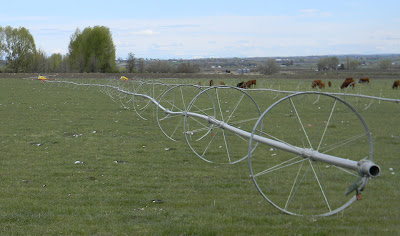The irrigation continues, despite the fact that we have snow on the ground this morning in Owyhee County.
This is a Center Pivot Sprinkler or, for short, a Pivot. This elaborate structure moves in a circle around a pivot at one end. The wheels each move at a slightly different speed to keep the sprinkler strait. Since the pivot end of the sprinkler releases much less water than the far side. Being a taller structure, a pivot can be used in taller crops, like corn, quite effectively. Conversely, since the pivot is so tall, the sprinkler heads are hung down below the structure by pipes called "drops." Some newer pivots can actually hinge in the middle, allowing them to water a square shaped fields more fully or to work around even more complexly shaped fields.
This one is called a Wheel Line. A wheel line is pretty simple. It's a pipe with sprinklers attached with wheels interspersed along the length. A four wheeled motor (those yellow boxes you can just see at the upper left of the picture) rotates the entire length of pipe so that the whole line will move, as one, across a field in a parallel fashion. As you can see, over the length of the line, (probably due to wind) a wheel line can get a significant curve to it. This is not good, because now the line doesn't really roll strait and will break if you try to move it. This line will probably have to be taken apart and rebuilt in a strait line. A time consuming job, if not a particularly difficult one.
This is the humble Hand Line. As you can see, it's just a pipe with sprinklers on it. They're called hand lines because if you ever want to move them, you have to pack them around with your hands. Nowadays they're most common in the corners of fields watered by center pivots. Since a center pivot generally waters a circle shaped area, and fields are generally square, you have to fill in the corners or leave them dry. Since a hand line works on a pressurized water system, just like the pivot, it fills the corners handily.
I still haven't covered all the ways that people irrigate their crops, but hopefully the variety impresses on you that it's a very important part of what farmers do. They're always interested in trying new ways to bring more, high quality food and resources to the public.




No comments:
Post a Comment